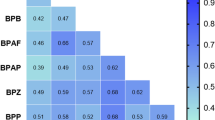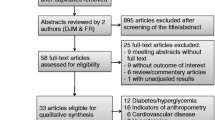Abstract
Bisphenol A (BPA) is an ubiquitous chemical, which is an endocrine disruptor. Recent epidemiological studies have suggested a relationship between BPA exposure and body weight. However, most of these studies were cross-sectional and not on elderly people. We conducted a panel study with repeated measurements to evaluate the relationship between BPA and overweight in elderly people. A total of 560 elderly participants aged ≥60 years were recruited in Seoul from 2008 to 2010. Urinary BPA levels and body mass index (BMI, kg/m2) were measured at every visit. We defined a BMI ≥25 as overweight and examined the relations between urinary BPA and BMI or overweight. Repeated measures analysis was performed after adjusting for age, sex, low-density lipoprotein cholesterol levels, alcohol consumption, regular exercise, total calorie intake, fatty acid intake, urinary cotinine levels, and the status of diabetes mellitus. The geometric mean of BPA was 0.67 μg/g creatinine. The odds ratio (OR) of overweight was 1.17 (95 % confidence interval [CI] 1.04–1.32) per interquartile range increase of log-transformed BPA. When stratified based on sex, we observed a significant association in women (OR 1.25; 95 % CI 1.09–1.45) but not in men (OR 0.97; 95 % CI 0.77–1.22). The ORs of overweight increased with quartiles of BPA in women (quartile 2 vs 1: OR 1.54; 95 % CI 1.02–2.32, 3 vs 1: OR 1.70; 95 % CI 1.10–2.62, and 4 vs 1: OR 1.81; 95 % CI 1.13–2.92). Our results suggest that urinary BPA levels are significantly associated with overweight in elderly women but not elderly men.

Similar content being viewed by others

References
Aballay LR, Eynard AR, Diaz Mdel P, Navarro A, Munoz SE (2013) Overweight and obesity: a review of their relationship to metabolic syndrome, cardiovascular disease, and cancer in South America. Nutr Rev 71:168–179. doi:10.1111/j.1753-4887.2012.00533.x
Alonso-Magdalena P, Morimoto S, Ripoll C, Fuentes E, Nadal A (2006) The estrogenic effect of bisphenol A disrupts pancreatic beta-cell function in vivo and induces insulin resistance. Environ Health Perspect 114:106–112
Alonso-Magdalena P, Quesada I, Nadal A (2011) Endocrine disruptors in the etiology of type 2 diabetes mellitus Nature reviews. Endocrinology 7:346–353. doi:10.1038/nrendo.2011.56
Bae S, Kim JH, Lim YH, Park HY, Hong YC (2012) Associations of bisphenol A exposure with heart rate variability and blood pressure. Hypertension 60:786–793. doi:10.1161/hypertensionaha.112.197715
Ben-Jonathan N, Hugo ER, Brandebourg TD (2009) Effects of bisphenol A on adipokine release from human adipose tissue: Implications for the metabolic syndrom. Mol Cell Endocrinol 304:49–54. doi:10.1016/j.mce.2009.02.022
Bhandari R, Xiao J, Shankar A (2013) Urinary Bisphenol A and Obesity in US Children. Am J Epidemiol. doi:10.1093/aje/kws391
Boucher JG, Boudreau A, Atlas E (2014) Bisphenol A induces differentiation of human preadipocytes in the absence of glucocorticoid and is inhibited by an estrogen-receptor antagonist. Nutr Diabetes 4:e102. doi:10.1038/nutd.2013.43
Calafat AM, Ye X, Wong LY, Reidy JA, Needham LL (2008) Exposure of the U.S. population to bisphenol A and 4-tertiary-octylphenol: 2003-2004. Environ Health Perspect 116:39–44. doi:10.1289/ehp.10753
Carwile JL, Michels KB (2011) Urinary bisphenol A and obesity: NHANES 2003-2006. Environ Res 111:825–830. doi:10.1016/j.envres.2011.05.014
CDC (2014) Fourth National Report on Human Exposure to Environmental Chemicals, Updated Tables. National Center for Environmental Health Division of Laboratory Sciences. http://www.cdc.gov/exposurereport/pdf/FourthReport_UpdatedTables_Jul2014.pdf. Accessed 7th August 2014
Chen CC et al (2008) Association among cigarette smoking, metabolic syndrome, and its individual components: the metabolic syndrome study in Taiwan. Metab Clin Exp 57:544–548. doi:10.1016/j.metabol.2007.11.018
Christensen KL, Lorber M, Koslitz S, Bruning T, Koch HM (2012) The contribution of diet to total bisphenol A body burden in humans: results of a 48 hour fasting study. Environ Int 50:7–14. doi:10.1016/j.envint.2012.09.002
Dekant W, Volkel W (2008) Human exposure to bisphenol A by biomonitoring: methods, results and assessment of environmental exposures. Toxicol Appl Pharmacol 228:114–134. doi:10.1016/j.taap.2007.12.008
Fernandez MF (2007) Bisphenol-A and chlorinated derivatives in adipose tissue of women. Reprod Toxicol (Elmsford, NY) 24:259–264. doi:10.1016/j.reprotox.2007.06.007
Gregoire FM, Smas CM, Sul HS (1998) Understanding adipocyte differentiation. Physiol Rev 78:783–809
Harley KG et al (2013) Prenatal and postnatal bisphenol A exposure and body mass index in childhood in the CHAMACOS Cohort. Environ Health Perspect 121:514–520. doi:10.1289/ehp.1205548
Hugo ER, Brandebourg TD, Woo JG, Loftus J, Alexander JW, Ben-Jonathan N (2008) Bisphenol A at environmentally relevant doses inhibits adiponectin release from human adipose tissue explants and adipocytes. Environ Health Perspect 116:1642–1647. doi:10.1289/ehp.11537
Ishunina TA, Kruijver FP, Balesar R, Swaab DF (2000) Differential expression of estrogen receptor alpha and beta immunoreactivity in the human supraoptic nucleus in relation to sex and aging. J Clin Endocrinol Metab 85:3283–3291
Jackson AS et al (2002) The effect of sex, age and race on estimating percentage body fat from body mass index. Heritage Family Study Int J Obesity and Relat Metab Disord: J Int Ass Study Obesity 26:789–796. doi:10.1038/sj.ijo.0802006
Ko A, Hwang MS, Park JH, Kang HS, Lee HS, Hong JH (2014) Association between urinary Bisphenol A and waist circumference in Korean adults. Toxicol Res 30:39–44. doi:10.5487/tr.2014.30.1.039
Li DK et al (2013) Urine bisphenol-a level in relation to obesity and overweight in school-age children. PLoS One 8:e65399. doi:10.1371/journal.pone.0065399
Mackay H, Patterson ZR, Khazall R, Patel S, Tsirlin D, Abizaid A (2013) Organizational effects of perinatal exposure to bisphenol-A and diethylstilbestrol on arcuate nucleus circuitry controlling food intake and energy expenditure in male and female CD-1 mice. Endocrinology 154:1465–1475. doi:10.1210/en.2012-2044
Masuno H, Iwanami J, Kidani T, Sakayama K, Honda K (2005) Bisphenol a accelerates terminal differentiation of 3 T3-L1 cells into adipocytes through the phosphatidylinositol 3-kinase pathway Toxicological sciences: an official journal of the Society of. Toxicology 84:319–327. doi:10.1093/toxsci/kfi088
Masuno H, Kidani T, Sekiya K, Sakayama K, Shiosaka T, Yamamoto H, Honda K (2002) Bisphenol A in combination with insulin can accelerate the conversion of 3 T3-L1 fibroblasts to adipocytes. J Lipid Res 43:676–684
Matthews JB, Twomey K, Zacharewski TR (2001) In vitro and in vivo interactions of bisphenol A and its metabolite, bisphenol A glucuronide, with estrogen receptors alpha and beta. Chem Res Toxicol 14:149–157
McCracken J et al (2010) Annual ambient black carbon associated with shorter telomeres in elderly men: Veterans Affairs Normative Aging Study. Environ Health Perspect 118:1564–1570
Mervish N et al (2014) Dietary predictors of urinary environmental biomarkers in young girls, BCERP, 2004-7. Environ Res 133c:12–19. doi:10.1016/j.envres.2014.04.040
Nadal A (2013) Obesity: Fat from plastics? Linking bisphenol A exposure and obesity. Nat Rev Endocrinol 9:9–10. doi:10.1038/nrendo.2012.205
Oh SY, Kim EM, Shin MH, Lee SH, Kim JE, Lee HS (2007) Development and validation of food frequency questionnaire for adults. Paper presented at the The Korean Society of Health Promotion Annual Spring Conference, Seoul, Korea; 2007., May 19, 2007
Robins JMR, Rotnitzky A, Zhao LP (1995) Analysis of semiparametric regression models for repeated outcomes in the presence of missing data. J Am Stat Assoc 90:106–121
Rochester JR et al (2013) Bisphenol A and human health: a review of the literature. Reprod Toxicol (Elmsford, NY) 42:132–155. doi:10.1016/j.reprotox.2013.08.008
Rogers JA, Metz L, Yong VW (2013) Review: Endocrine disrupting chemicals and immune responses: a focus on bisphenol-A and its potential mechanisms. Mole Immunol 53:421–430. doi:10.1016/j.molimm.2012.09.013
Rubin BS (2011) Bisphenol A: an endocrine disruptor with widespread exposure and multiple effects. J Steroid Biochem Mole Biol 127:27–34. doi:10.1016/j.jsbmb.2011.05.002
Rubin BS, Soto AM (2009) Bisphenol A: perinatal exposure and body weight. Mole Cell Endocrinology 304:55–62. doi:10.1016/j.mce.2009.02.023
Rudel RA et al (2011) Food packaging and bisphenol A and bis(2-ethyhexyl) phthalate exposure: findings from a dietary intervention. Environ Health Perspect 119:914–920. doi:10.1289/ehp.1003170
Sabanayagam C, Teppala S, Shankar A (2013) Relationship between urinary bisphenol A levels and prediabetes among subjects free of diabetes. Acta Diabetologica 50:625–631. doi:10.1007/s00592-013-0472-z
Shankar A, Teppala S, Sabanayagam C (2012) Urinary bisphenol a levels and measures of obesity: results from the national health and nutrition examination survey 2003-2008 ISRN endocrinology 2012:965243 doi:10.5402/2012/965243
Shin MH et al (2013) J Epidemiol/Japan Epidemiol Assoc 23:122–131
Song Y, Hauser R, Hu FB, Franke AA, Liu S, Sun Q (2014) Urinary concentrations of bisphenol A and phthalate metabolites and weight change: a prospective investigation in US women. Int J Obesity (2005). doi:10.1038/ijo.2014.63
Stahlhut RW, Welshons WV, Swan SH (2009) Bisphenol A data in NHANES suggest longer than expected half-life, substantial nonfood exposure, or both. Environ Health Perspect 117:784–789. doi:10.1289/ehp.0800376
Trasande L, Attina TM, Blustein J (2012) Association between urinary bisphenol A concentration and obesity prevalence in children and adolescents. JAMA: J Am Med Assoc 308:1113–1121. doi:10.1001/2012.jama.11461
Volkel W, Bittner N, Dekant W (2005) Quantitation of bisphenol A and bisphenol A glucuronide in biological samples by high performance liquid chromatography-tandem mass spectrometry. Drug Metab Dispos: Biol Fate Chem 33:1748–1757. doi:10.1124/dmd.105.005454
Volkel W, Colnot T, Csanady GA, Filser JG, Dekant W (2002) Metabolism and kinetics of bisphenol a in humans at low doses following oral administration. Chem Res Toxicol 15:1281–1287
Wada K, Sakamoto H, Nishikawa K, Sakuma S, Nakajima A, Fujimoto Y, Kamisaki Y (2007) Life style-related diseases of the digestive system: endocrine disruptors stimulate lipid accumulation in target cells related to metabolic syndrome. J Pharmacol Sci 105:133–137
Wang B, Wang H, Zhou W, He Y, Zhou Y, Chen Y, Jiang Q (2014) Exposure to bisphenol A among school children in eastern China: a multicenter cross-sectional study. J Expo Sci Environ Epidemiol. doi:10.1038/jes.2014.36
Wang HX, Zhou Y, Tang CX, Wu JG, Chen Y, Jiang QW (2012a) Association between bisphenol A exposure and body mass index in Chinese school children: a cross-sectional study. Environ Health : A Glob Access Sci Sour 11:79. doi:10.1186/1476-069x-11-79
Wang T et al (2012b) Urinary bisphenol A (BPA) concentration associates with obesity and insulin resistance. J Clin Endocrinol Metab 97:E223–E227. doi:10.1210/jc.2011-1989
Wc W (1998) Nutritional Epidemiology. Oxford university press, New York
WHO (2004) Appropriate body-mass index for Asian populations and its implications for policy and intervention strategies. Lancet 363:157–163. doi:10.1016/s0140-6736(03)15268-3
Xia X, Serrero G (1999) Inhibition of adipose differentiation by phosphatidylinositol 3-kinase inhibitors. J Cell Physiol 178:9–16. doi:10.1002/(sici)1097-4652(199901)178:1<9::aid-jcp2>3.0.co;2-#
Yang YJ, Hong YC, Oh SY, Park MS, Kim H, Leem JH, Ha EH (2009) Bisphenol A exposure is associated with oxidative stress and inflammation in postmenopausal women. Environ Res 109:797–801. doi:10.1016/j.envres.2009.04.014
Ye X et al (2008) Urinary metabolite concentrations of organophosphorous pesticides, bisphenol A, and phthalates among pregnant women in Rotterdam, the Netherlands: the Generation R study. Environ Res 108:260–267. doi:10.1016/j.envres.2008.07.014
Acknowledgments
This study was supported by the Environmental Exposures and Health Effects in Elderly Population program (0411-20080013, 0411-20090007, 0411-20100016) of the Ministry of Environment, Republic of Korea.
Conflict of interest
The authors declare that they have no conflict of interests.
Author information
Authors and Affiliations
Corresponding author
Additional information
Responsible editor: Philippe Garrigues
Electronic supplementary material
Below is the link to the electronic supplementary material.
ESM 1
(DOCX 32 kb)
Rights and permissions
About this article
Cite this article
Lee, MR., Kim, J.H., Choi, YH. et al. Association of bisphenol A exposure with overweight in the elderly: a panel study. Environ Sci Pollut Res 22, 9370–9377 (2015). https://doi.org/10.1007/s11356-015-4087-5
Received:
Accepted:
Published:
Issue Date:
DOI: https://doi.org/10.1007/s11356-015-4087-5



